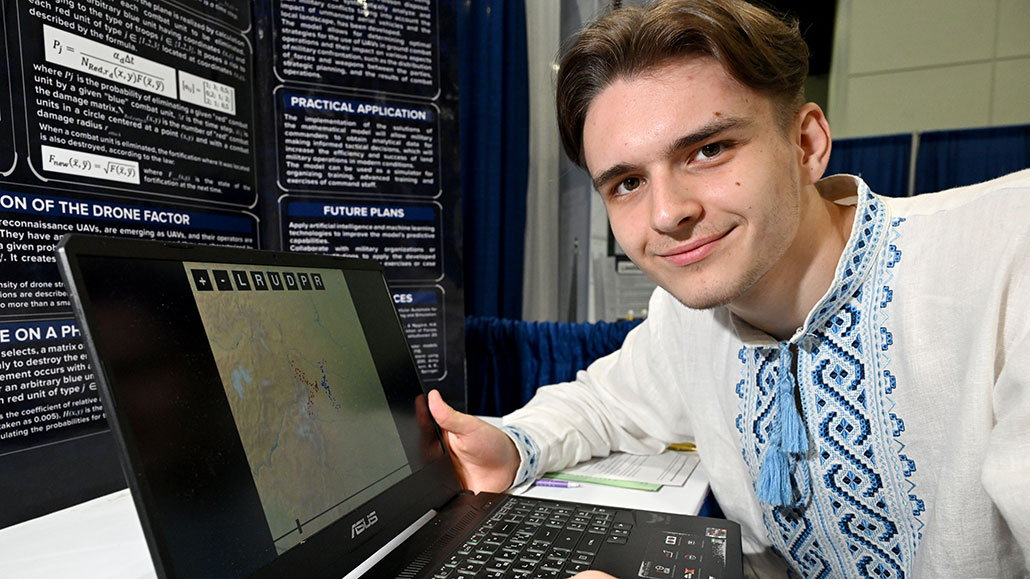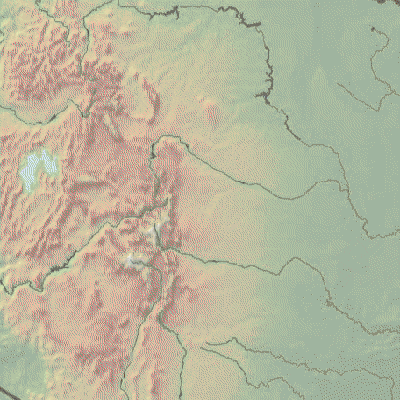Teen’s battle simulator could help Ukraine’s troops fend off attacks
His software accounts for drones and landscape features to better predict battle outcomes

Advanced robotics, especially use of drones, has changed the game in military tactics. At Regeneron ISEF, Volodymyr Borysenko showcased software for potential use by his nation’s frontline troops. It simulates battles, accounting for enemy drones and mapped features of Ukraine’s landscape.
CHRIS AYERS PHOTOGRAPHY/SOCIETY FOR SCIENCE
LOS ANGELES, Calif. — More than two years ago, Russia launched a takeover attempt against neighboring Ukraine. Volodymyr Borysenko wanted to help his country defend itself in the invasion that followed. The rising 12th grader attends Cherkasy School Number 28 in Ukraine. He has just developed software that simulates battles in a new way. He hopes it can one day improve how Ukraine’s troops and commanders train and plan their ground maneuvers.
Volodymyr, 17, was a finalist at the Regeneron International Science and Engineering Fair (ISEF). It’s a program of the Society for Science. (The Society also publishes this magazine). For his work, the teen earned a full scholarship from King Fahd University of Petroleum and Minerals in Saudi Arabia. He also took home a $400 prize.
Why focus his coding on war tactics? “I want to help the Ukrainian military because they have problems on the front lines,” Volodymyr explains. When it comes to ground conflict, he says, “I heard from them that we lack strategic planning.”
Currently, he says, the military relies on two battle-simulation programs. One of them doesn’t account for sites where ground troops can take a breather to recover. The other ignores battlefield robotics.
To fill in such gaps, Volodymyr’s software includes the activities of flying drones. It also adds landscape features. These include such things as rivers, tree cover and shelters used by troops.
His research goal: “to minimize losses among [our] military.”
Do you have a science question? We can help!
Submit your question here, and we might answer it an upcoming issue of Science News Explores
Simulating battles
The teen has been programming computers since seventh grade. Over the past few years, he has joined robotics clubs and taken part in programming and math olympiads. He even worked on machine-learning software. But these days, Volodymyr says, “I decided that military tech is more useful for my country.”
The teen’s software relies on a lot of math to model two battling opponents. These include their soldiers and tanks. It plots their movements atop a map showing land features. The program then adapts troop movements based on what’s known about how many enemy troops there are and how fortified their positions are.
The software then predicts how likely it is that the troops (on each side) will incur harm.
Its calculations rely on factors such as the number of nearby enemy troops and how many attack and spy drones have been deployed. Especially novel, the teen says, has been its mapping of these against specific features of Ukraine’s landscape.
For instance, fighting from higher ground can give troops advantages. They have a better viewpoint. And having to climb upward also tends to slow an enemy’s advance.
Overall, the software predicts how successful a military operation might be. It then sets a number of acceptable losses among the troops. Based on these, it analyzes what actions Ukraine’s troops might take to keep its losses to a minimum.
Volodymyr designed his software to run on the average laptop. He expects it could be used by a frontline commander to simulate different battle strategies. That commander could then decide which would work best, while keeping casualties low.
“I hope that it can be used in warfare modeling,” he says, “and in simulation of battles to minimize risks among [our] people.” See the teen describing his research in a video.

Volodymyr’s program shows troops from two warring sides, represented in red and blue by small dots. It simulates their doing battle atop a map depicting real physical features of the landscape. A user can move around the map and zoom in and out using controls at the top of the screen.
Moving forward
Volodymyr’s software is in its early stages. Still, it has been tested at the National Defense Academy of Ukraine. It’s not yet ready for use on the front lines, the teen says. But people at the academy, Volodymyr says, told him that they thought his software could help soldiers train and evaluate strategies.
He now plans to add more types of drones to the simulations. He also wants to add analyses of battles on the water. That might help Ukraine’s Navy.
Volodymyr has endured hardships that many young researchers can’t imagine. Chief among them: the ravages of war. Although his hometown wasn’t at the front, power outages and air-raid alerts have been common. Sometimes he has gone days without power or had power for only a few hours a day. He’d have to quickly recharge his devices whenever the power came on so that his screens would work for a while after the power went off again.
Such disruptions taught this teen the value of work-around plans. Whatever you care about, it’s important to continue pushing an idea forward, despite hardships, he now says. If you do, he says, “You can make an impact on the world.”
Volodymyr was among nearly 2,000 Regeneron ISEF finalists who competed from almost 70 countries, regions and territories for more than $9 million in prizes. The Society for Science has run this yearly high-school event since creating it in 1950.







